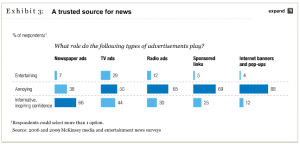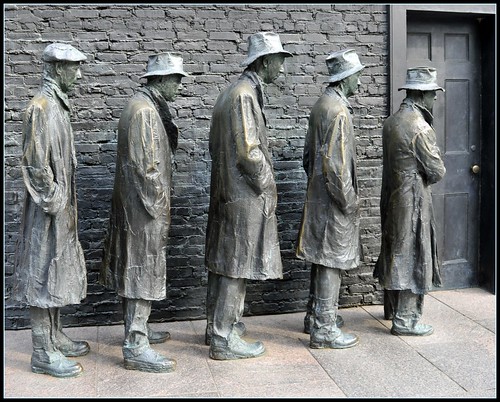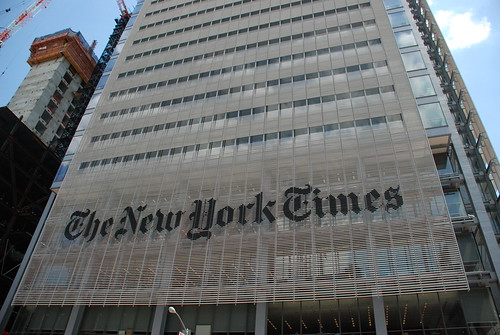McKinsey Quarterly has some good news for newspapers. It’s been looking at readership trends in the UK and sees growing interest in news from under 35-readers. In fact, daily time spent consuming news in the critical 25-to-34 age category is up 37% from three years ago (you have to register to read the report or you can download a PDF here). People in that age group prefer to consume the news on the Internet rather than in print, but the good news is that they trust newspapers more than any other source: “66 percent describe newspaper advertising as ‘informative and confidence inspiring,’ compared with only 44 percent for TV and 12 percent for the Web,” the report says.
 The report is pessimistic on the chances that existing business models will ever transition successfully online. It notes that only one in seven UK news consumers declared a willingness to pay for content. However, the trust factor should embolden publishers to seek more innovative revenue models, including advertorials and transaction fees.
The report is pessimistic on the chances that existing business models will ever transition successfully online. It notes that only one in seven UK news consumers declared a willingness to pay for content. However, the trust factor should embolden publishers to seek more innovative revenue models, including advertorials and transaction fees.
In our view, this is news organizations’ best shot. As the volume of online information grows by leaps and bounds, the need for trusted sources grows with it. Publishers need to discard their not-invented-here thinking and look for ways to aggregate information in ways that command a premium value. We also really like the transaction fee idea. We’ve been pushing that one for about a year.
Google CEO Brings Upbeat Message
Google CEO Eric Schmidt was on hand Sunday night to speak to members of the American Society of Newspaper Editors and tell them what they already knew: their content is valuable but their business model is broken. However, the executive had encouraging words. “There’s every reason to believe that eventually we’ll solve this,” he said, pointing to emerging but still unspecified subscription models that Google and others will develop. Schmidt later told reporters that he doesn’t know what the solution will look like, but it will probably be a combination of subscriptions and advertising.
Schmidt prodded the editors to focus on mobile devices like the Apple iPad and Google Android, noting that publishers will need to address all popular form factors and not simply look to the iPad or the Amazon Kindle as a cure-all. “When I say Internet first, I mean mobile first,” he said. He also asserted that new sites themselves will need to become smarter, not only habituating themselves to the interests of the readers but also presenting them with selected information they don’t necessarily choose to consume. In comments to Paidcontent.org, he reiterated his confidence: “This problem will be solved when newspapers are making bundles of money and the sooner we can make that happen …”
Miscellany
If you’re considering instituting a pay wall for your newspaper, you might want to head on over to Paidcontent.org, which has assembled a list of 26 newspapers that are now charging readers for online access. The subscription fees are all over the map, ranging from less than $1 per month for online access bundled with print subscriptions at the Vineyard Gazette to $20 at Newsday. The chart doesn’t include The Wall Street Journal, which has been charging a subscription fee for years. Paidcontent.org says the list is about to expand by at least six other titles which have announced plans to erect pay walls but haven’t gone live yet.
The Newspaper Association of America’s mediaXchange conference is going on live in Orlando this week and the organization is providing some live video coverage as well as blogs and a Twitter feed. Five sessions will be webcast live between now and Wednesday, including one by the Director of Global Online Sales and Operations at Facebook and another Jeff Hayzlett, the Chief Marketing Officer at Kodak. The Kodak presentation could be particularly interesting, because that company faced a crisis that many newspapers can identify with: its core paper business was displaced by electrons years ago.
The founder of journalismjobs.com says he’s seeing some revival in the recruitment market for journalists. “Even with newspapers – which are supposed to be dead – I’m seeing a good number of traditional openings being advertised as well as online jobs,” said Dan Rohn. He pointed to The Wall Street Journal’s plans to hire 35 reporters and editors to cover New York as well as new postings at small papers like the Green Bay Press-Gazette, York (Pa.) Daily Record and Lawrence (Mass.) Eagle-Tribune. That’s just a sampling, Rohn said, implying that journalists would be well served by going to his website for more opportunities.
Tribune Co. has reached a deal to emerge from bankruptcy protection later this year, apparently with its existing management intact. The deal was negotiated by a group of the bankrupt publishers senior lenders, who will control 91% of the stock of the reorganized company. It’s been challenged by a group of junior stakeholders who say they were excluded from the negotiations. Tribune filed for bankruptcy 16 months ago and has sold its stake in the Chicago Cubs and Wrigley Field in an effort to pare down more than $8 billion in debt. The creditor committee was vague on how the proposed reorganization will permit Tribune to emerge with sufficient operating capital to remain liquid.

 In it, Loyola journalism professor Michael Giusti (right) makes a misguided assumption that the
In it, Loyola journalism professor Michael Giusti (right) makes a misguided assumption that the 

















